After a workshop where three local knitting guild members taught us an introduction into Fair Isle knitting, it is no longer intimidating. After four decades of knitting, I think perhaps it could become a new obsession for this old dame.
Fair Isle knitting began on the Shetlands islands centuries ago. It is an excellent way to use up bits of yarn used for previous projects. Very Scotch. The Prince of Wales popularized this form of knitting when he appeared in Fair Isle vests in 1921.
On display at Shetland Museum
Fair Isle knitting uses only two colors per row with one of the two colors becoming the background color. This child's jumper (termed sweater in the US) was from 1924. It was made for a child, and as she grew, cuffs and the bottom were lengthened by adding on more knitted rows in brown. Again,very economical and a method to make the most of this jumper as it could last a girl through her primary years in school.
These ladies are knitting while we happened by, and were king enough to let me snap their pictures. Shortbread had been packed for their tea. Their shortbread was packed in the white plastic container.
After a workshop teaching us how to knit Fair Isle, manipulating two colors of yarn in one hand, I was able to produce this writer that will be turned into an iTouch holder.
Fair Isle is a traditional knitting technique used to create patterns with multiple colours. It is named after Fair Isle, a tiny island in the north of Scotland, that forms part of the Shetland-islands. Fair Isle knitting gained a considerable popularity when the Prince of Wales (later to become Edward VIII) wore Fair Isle tank tops in public in 1921. Traditional Fair Isle patterns have a limited palette of five or so colours, use only two colours per row, are worked in the round, and limit the length of a run of any particular colour. Traditional Fair Isle patterns have a limited palette of five or more colors, only two colors per row, and are worked in the round. (Wikipedia)
We visited Doreen Brown's shop and saw these swatches on the wall for selection by the customer just in case one did not prefer what was available.













































